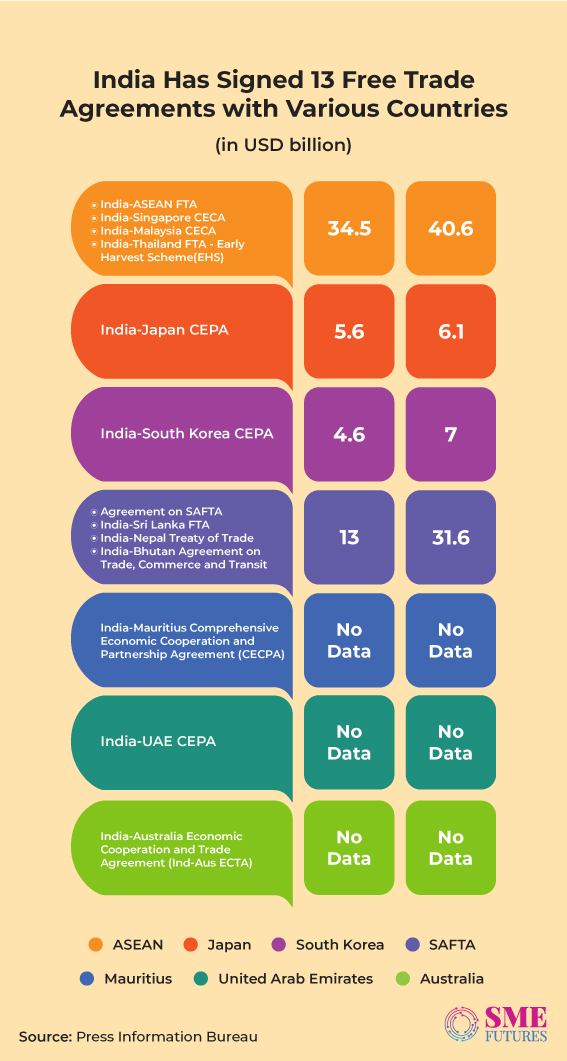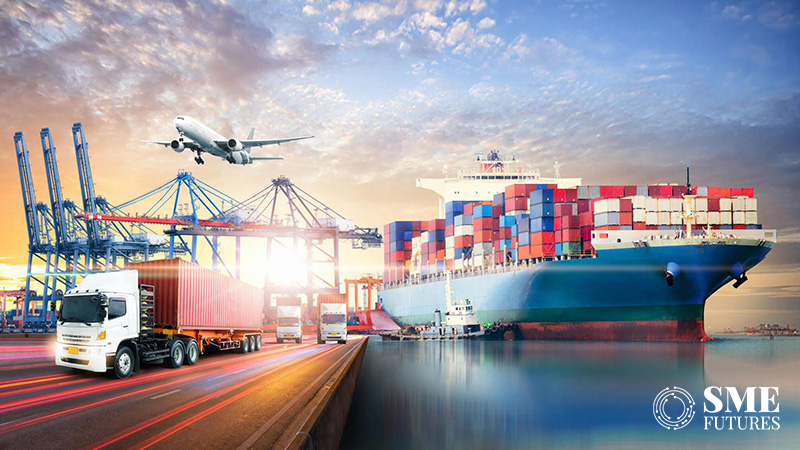India, a prominent player on the world stage, has actively pursued Free Trade Agreements (FTAs) to harness global trade opportunities. This article delves into the nuances of India’s FTAs, leveraging data from official government sources to dissect their tangible benefits and debunk the prevalent myths surrounding them.
FTA dynamics and India’s strategic engagement
For the uninitiated, a Free Trade Agreement (FTA) is a specific type of regional trade agreement that eliminates tariffs and other trade barriers on goods traded between the member countries. FTAs may also include provisions on trade in services and investment, but they are primarily focused on reducing tariffs on goods.
In specific terms, FTAs are a cornerstone of international trade, fostering collaboration by dismantling trade barriers.
Nowadays, India has suddenly accelerated the signing of bilateral trade agreements starting in 2021. For example, the Australia-India ECTA in 2022, the India-UAE CEPA, and the India-Mauritius CECPA in 2021.
Advanced discussions are underway with the UK and Canada too. Signing Free Trade Agreements (FTAs) with the EU and Israel is also a stated goal. India has strategically entered various FTAs, notably the ASEAN-India FTA, the India-Japan Comprehensive Economic Partnership Agreement (CEPA), and the India-Singapore Comprehensive Economic Cooperation Agreement (CECA). Analysing data from the Government of India, we can ascertain the impact of these agreements on India’s economic landscape.
FTAs importance and their economic benefits
Market access and diversification: According to the Ministry of Commerce and Industry, the ASEAN-India FTA has substantially increased market access. From 2010 to 2022, Indian exports to ASEAN nations grew at a Compound Annual Growth Rate (CAGR) of 12.4 per cent, showcasing the effectiveness of the agreement in promoting economic diversification.
Foreign direct investment (FDI) inflows: Data from the Department for Promotion of Industry and Internal Trade indicates a consistent rise in FDI inflows associated with FTAs. The India-Japan CEPA, for instance, has seen a 27 per cent increase in Japanese FDI inflows since its implementation in 2011, signalling heightened investor confidence.
Competitive edge: The adoption of global standards and practices through FTAs is evident in the increase in India’s World Bank Ease of Doing Business ranking. According to the World Bank, India climbed from 142nd in 2014 to 63rd in 2022, showcasing the positive impact of aligning with global norms on competitiveness.
Economic growth and job creation: Government data from the Ministry of Statistics and Programme Implementation highlights a positive correlation between FTAs and economic growth. The manufacturing sector, buoyed by increased exports facilitated by FTAs, has seen a steady rise in Gross Value Added (GVA), leading to job creation and a robust economic trajectory.
Now let’s see where India has participated in foreign trade.
India’s FTAs
So far India has signed 13 FTAs with its trading partners, including the following three agreements:
- India-Mauritius Comprehensive Economic Cooperation and Partnership Agreement (CECPA).
- India-UAE Comprehensive Partnership Agreement (CEPA).
- India-Australia Economic Cooperation and Trade Agreement (IndAus ECTA).
The list of FTAs signed by India is:

Examining India’s FTAs through case studies
The Comprehensive Economic Partnership Agreement (CEPA) between India and the United Arab Emirates (UAE) reinforces India’s commitment to the Israel-United Arab Emirates (I2-U2), also known as the western quadrant of the Arab League, a regional force that was established in October 2021. With China absent, this arrangement gives India access to its western neighbours, who can help with trade agreement negotiations.
The Gulf Cooperation Council (GCC)-India FTA improves India’s relations with the GCC countries and moves the country closer to achieving an FTA with them. In terms of the economy, the trade agreement is expected to boost service trade, nearly triple bilateral commodities commerce, and create 10 lakh jobs in labour-intensive industries by 2027.
Geopolitical relations between Australia and India are strengthened by the Australia-India Economic Cooperation and Trade Agreement (ECTA). A more extensive free trade agreement known as the Comprehensive Economic Cooperation Agreement (CECA) between the two countries will cover several additional topics, including investments, services, government procurement, and intellectual property. The close ties between Australia and India will support the development of an Australia-India specialty even inside the QUAD.
ASEAN-India FTA: The Department of Commerce’s trade data indicates a significant surge in India’s exports to ASEAN nations post the implementation of this FTA in 2010. Sectors like pharmaceuticals, textiles, and chemicals have experienced notable growth.
India-Japan CEPA: According to the Ministry of External Affairs, the India-Japan CEPA has not only spurred bilateral trade but has also led to enhanced technology transfer. Japanese investments, as reported by the Ministry of Finance, have catalysed growth in the automotive and technology sectors, affirming the strategic benefits of the agreement.
Regional Comprehensive Economic Partnership (RCEP): Although India opted out of the final RCEP agreement, data from the Ministry of Commerce and Industry emphasises the comprehensive nature of the negotiations. Insights into the potential benefits underscore the strategic importance of participating in large regional trade agreements.
With fifteen participating countries, the Indo-Pacific Economic Framework for Prosperity (IPEF), an economic effort spearheaded by the Biden administration, offers a huge opportunity to sign a regional trade deal and establish a trade bloc independent of China. Being a member, India will undoubtedly gain if that occurs.
But there are some myths associated with FTAs that need to be understood.
Myths associated with FTAs
An FTA like any other treaty, is not a panacea for all problems. The Global Trade Research Initiative (GTRI) in its ‘India FTA Outlook 2024’ report has identified some of the popular myths associated with FTAs.
FTAs facilitate most of the global trade:
The analysis reveals that only 15–17 per cent of global trade is carried out through FTAs, refuting the popular perception. Although FTA partners are involved in 40 per cent of global trade, most of it is conducted under Most Favoured Nation (MFN) duties rather than FTA regulations. More than half of global trade occurs at zero MFN duty and roughly thirty per cent occurs at low MFN duty. For example, preferential treatment receives only 6 per cent of India’s $12 billion (about $37 per person in the US) in exports to Singapore. More than 70 per cent of Indian exports are duty-free when they enter ASEAN.
FTAs have weakened the World Trade Organisation:
While FTAs had this potential, they could not dent the multilateral trading system as far as standard trade instruments like tariffs are concerned. The reason being that most (about 83-85 per cent) of world trade takes place outside the FTAs using the Most Favoured Nation duties agreed under the WTO rules.
FTAs automatically lead to accelerated increase in exports:
This is not true for India.
In India’s case, FTAs haven’t significantly accelerated export growth. India’s trade deficit with its FTA partners has risen more than its global trade deficit. For example, India’s cumulative merchandise trade deficit with most FTA partners increased at a much higher rate than India’s global trade deficit. For the period of the pre-FTA era (2007-09) and current trade (2019-21) the trade deficit increase data is: ASEAN-201.5 per cent, South Korea-142.5 per cent, and Japan-120.6 per cent. India’s merchandise trade deficit with the world grew by 43.1 per cent during this period.
With low import duties in partner countries, FTAs benefit only specific product groups.
Use of FTAs by Indian exporters is high:
India’s exports using FTAs enable tariff preferences as the share of total merchandise exports to the FTA partner country remains low. FTAs lower the import duty, but if it is already zero, they offer no benefit. This is the biggest reason behind most Indian firms not using FTAs for exports.
Most trade happens at zero MFN duties in India’s partner countries. The percentage of global imports happening at zero MFN duty in India’s FTA partner countries: Singapore- 99.8 per cent, Malaysia-82 per cent, Japan-81 per cent, Vietnam-61.4 per cent, South Korea-41.7 per cent. On products covered under such headings, FTAs offer no additional market access to Indian exporters.
Dispelling other popular myths through government statistics:
Some of the other common myths associated with FTAs have been discussed in the underlying section.
Job losses and wage suppression:
Contrary to the myths surrounding job losses, the Ministry of Labour and Employment reports a net gain in employment across sectors impacted by FTAs. The creation of 3.79 million jobs in 2021 alone underscores the fallacy of the notion that FTAs lead to widespread unemployment.
Trade deficits:
Data from the RBI reveals that trade deficits are influenced by various factors beyond FTAs. While trade deficits exist, attributing them solely to FTAs oversimplifies the complex dynamics of international trade. Moreover, FTAs contribute significantly to narrowing trade deficits by boosting exports.
Erosion of sovereignty:
The assertion that FTAs compromise national sovereignty is debunked by the fact that these agreements are voluntary and negotiated to safeguard national interests. The Ministry of External Affairs emphasises the collaborative nature of FTAs, highlighting that participating nations retain control over their domestic policies.
SMEs disadvantage:
The Ministry of MSMEs dispels the myth of SMEs being disadvantaged, pointing to specific provisions in FTAs that support their growth. Measures such as simplified customs procedures, preferential treatment, and capacity-building initiatives are tailored to ensure that SMEs thrive within the FTA framework.
As India continues its journey in the global economic arena, data-driven insights become imperative for informed decision-making. Embracing FTAs not only positions India as a key player in the international trade landscape but also paves the way for a more interconnected and mutually beneficial global economy.











